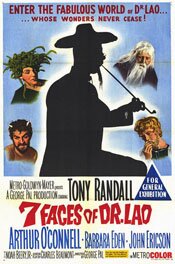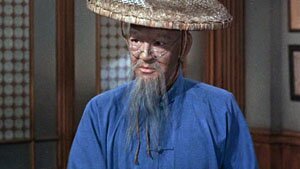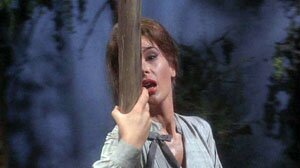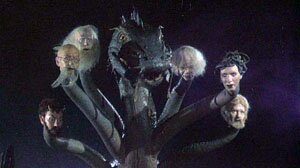You can see a number of actors best known for their television work in the 1960s and 1970s — Tony Randall, Barbara Eden and Arthur O’Connell — in one of the oddest films: 7 Faces of Dr. Lao.
Is it a fantasy? Without a doubt. Is it a western? I think so. Is it good? Umm … well, that’s one I’ll avoid but I’ll say this — I found it entertaining!
 7 Faces of Dr. Lao
7 Faces of Dr. Lao
Directed by George Pal
This movie, 7 Faces of Dr. Lao, is peculiar to say the least, and in its peculiarity is a wonderful fantasy that doesn’t make for the greatest film ever made but a delightful one nonetheless.
Once seen, it’s not surprising to find it is directed by George Pal, who gave us such movies as The Time Machine. Based on a novel by Charles G. Finney titled The Circus of Dr. Lao, the movie is an odd cross between a typical western and fantasies like The Golden Voyage of Sinbad. (That movie was not directed by Pal.)
I make that comparison because you don’t often come across a western that employs old school animation. I believe it was called claymation.
 To begin with, though dressed up in western garb the movie takes its first left turn when its lead character, Dr. Lao played by Tony Randall, shows up. He is Chinese – or is he? His accent changes as the situation demands, deliberately. Dr. Lao has brought his circus to the town of Abilone (and Randall plays all the characters in the circus, including Merlin and the Abominable Snowman).
To begin with, though dressed up in western garb the movie takes its first left turn when its lead character, Dr. Lao played by Tony Randall, shows up. He is Chinese – or is he? His accent changes as the situation demands, deliberately. Dr. Lao has brought his circus to the town of Abilone (and Randall plays all the characters in the circus, including Merlin and the Abominable Snowman).
The story is relatively simple and progresses more or less episodically. Dr. Lao comes to a town and using his circus and magic and stories that teach lessons, reveals the town to itself. In doing so, he saves it from disappearing by selling out to a cynical land baron, Clint Stark played by Arthur O’Connell.
The rich and greedy man trying to buy a town to capitalize on a railroad that will soon be coming is a standard, even cliché western story. This movie would be just another, average version of that story except for its fantasy element. (The movie also has its obligatory love story as a romantic John Ericson tries to woo a resistant and bundled-up school teacher, Barbara Eden.)
 Several things make the movie stand out. The first is the unusual use of an Asian as the lead character – something unheard of for the period (1964) and especially so for a western. However, typical of the period, the Asian isn’t Asian – it’s a white Hollywood actor (Tony Randall) doing a characterization of an Asian (which, like Mickey Rooney’s Japanese man in Breakfast at Tiffany’s, probably makes the hair stand on end for anyone from an Asian country).
Several things make the movie stand out. The first is the unusual use of an Asian as the lead character – something unheard of for the period (1964) and especially so for a western. However, typical of the period, the Asian isn’t Asian – it’s a white Hollywood actor (Tony Randall) doing a characterization of an Asian (which, like Mickey Rooney’s Japanese man in Breakfast at Tiffany’s, probably makes the hair stand on end for anyone from an Asian country).
On the other hand, as it does this it also suggests that Dr. Lao might not be Asian but rather what is actually the case, a white man mimicking a western world idea of a man from China. So the movie plays it cute and cagey in this repect.
Something else that makes the movie unusual (and mentioned already) is the use of claymation. Who on earth ever heard of that in a western? One result of this is to date the movie. Seen today, the movie either has a nostalgic quality for anyone who grew up seeing these kinds of movies or, for many others, it has a retro, kitsch quality.
 For me, the aspect I find truly interesting, and where I think this movie really veers off from its surface western look, is in how the “bad guy,” Stark, isn’t really so bad. His character is as cynical as he is because as a younger man he was so idealistic. In the end, he is happy because he has lost and thus proven wrong. And throughout the movie, he may be the nicest bad guy movies have ever seen. He’s almost always smiling.
For me, the aspect I find truly interesting, and where I think this movie really veers off from its surface western look, is in how the “bad guy,” Stark, isn’t really so bad. His character is as cynical as he is because as a younger man he was so idealistic. In the end, he is happy because he has lost and thus proven wrong. And throughout the movie, he may be the nicest bad guy movies have ever seen. He’s almost always smiling.
7 Faces of Dr. Lao is not a great movie – not by a long shot. But it is very entertaining, moves quickly, and is a more than a little fascinating for its numerous quirks. And as movies go, it’s about retro as retro gets.


